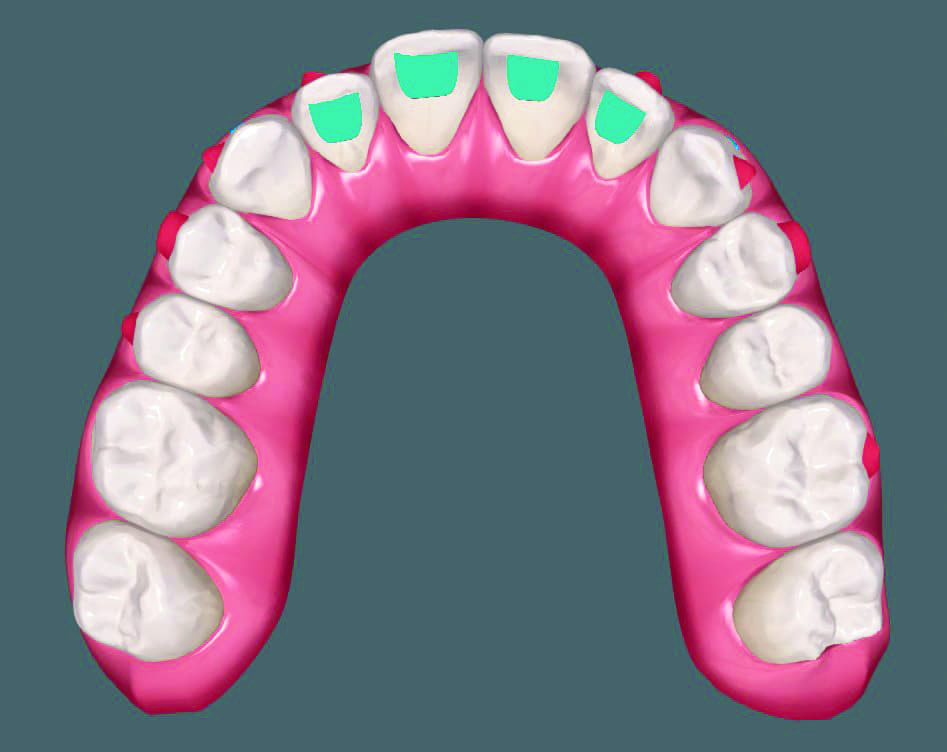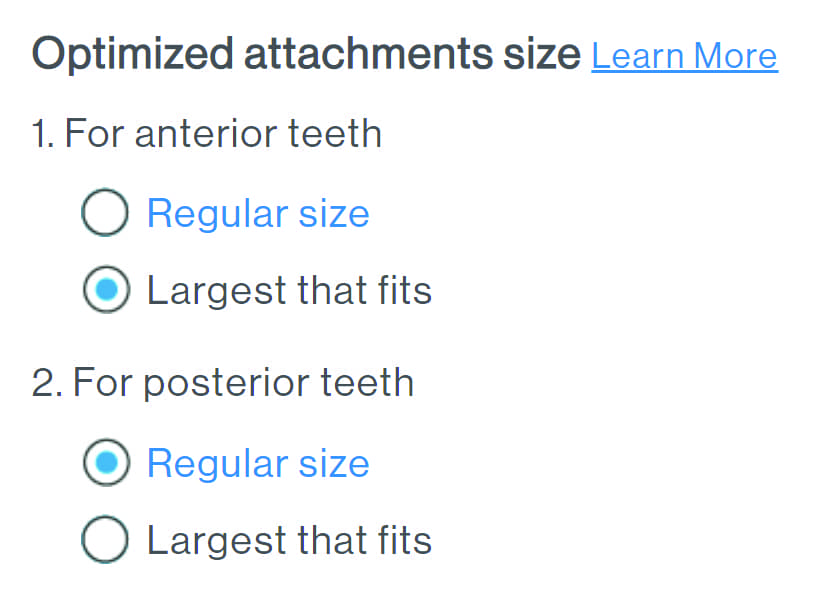The technology around Invisalign has advanced in leaps and bounds. So it’s only right for Dr Glaser to offer an update to his Invisalign 10 Commandments and provide advice on how to maximize Invisalign treatment design.
By Barry J. Glaser, DMD
In 2016, I wrote an article for Orthodontic Products titled Dr Glaser’s 10 Commandments of Attachment Design, that proved to be one of one of their most frequently read online articles. That article discussed 10 manual attachment adjustments I routinely made to help improve tracking and results with Invisalign.
In the world of technology, 6 years is a very long time. The science behind Invisalign treatment has rapidly advanced, and I no longer find it necessary to make many of these adjustments. So here, I once again descend from the mountain to bestow upon my readers a new look at my 10 Commandments, this time focusing on Invisalign treatment design.
1. Thou shalt trust the system
Back in 2016, my mindset was “the aligner grabs the attachment and pushes the tooth around.” As a result, I was frequently placing large conventional attachments with the goal of forcing the tooth into position—or what’s known as the displacement model of tooth movement. Essentially, the shape of the aligner matches the shape of the tooth, and displaces that shape in space.
While this thinking produced good results for me, I was naïve in my understanding of how the Invisalign system utilized the concept of biomechanics to achieve tooth movement.
In a biomechanical system, the shape of the aligner differs from the shape of the tooth at each stage, resulting in a force system being placed to achieve the desired tooth movement. In effect, I was overriding much of the sophistication built into the system.
Today, the Invisalign system is the most advanced clear aligner system in the world, powered by the trio of SmartForce features, SmartTrack aligner material, and SmartStage technology. Invisalign clear aligners precisely control tooth movement using optimized attachments and SmartForce aligner activations. SmartTrack aligner material is highly elastic and provides an excellent fit. And the SmartStage aligner activations are an optimized progression of tooth movements developed to increase predictability. Now on the 8th generation, G8, there is an impressive track record of over 12 million cases treated worldwide.
For me, this has led to a 180-degree shift in my approach to ClinCheck treatment planning. Whereas in 2016 I was making many manual adjustments to attachments and staging, I no longer find those necessary. I trust the system and you should too.
2. Thou shalt not take default velocity in vain
There are many opinions regarding modifying the velocity of movement, and some doctors routinely slow down velocity by increasing the number of aligner stages. Personally, I never understood why reducing the force applied to a tooth would encourage better tracking.
Think of it this way; if you have a patient in braces and you are not seeing good movement with a .014″ NiTi, would you go down to a .012″? I don’t. Most frequently, a slow moving tooth requires more force, not less. Granted, extremely high orthodontic forces can lead to slower movement through hyalinization; however, the concept of slowing velocity is not, as I understand it, designed to prevent hyalinization. Rather, slowing velocity is done to try to keep the tooth completely seated in the aligner. What is concerning to me is the paradox that slowing velocity reduces the force being applied to the tooth to suboptimal levels, possibly leading to poor tracking. From a non-scientific, anecdotal point of view, I never slow velocity and don’t think I have more non-tracking issues because of it. Personally, I don’t think it’s necessary.
3. Thou shalt remember to keep optimized attachments
This is one of the biggest changes for me. Optimized attachments, along with SmartStage aligner activations, work very well. Honestly, way better than I believed they did back in 2016. These days, I very rarely substitute conventional attachments for optimized ones. I simply no longer find it necessary. This has resulted in reduced time spent modifying my ClinCheck treatment plans and fewer ClinCheck plan revisions. It amazes me to see that some doctors request “remove all optimized attachments” on all their cases. My opinion, after thousands of patients treated, is that routine removal of optimized attachments is unnecessary and often counterproductive.

4. Thou shalt honor thy optimized deep bite attachments
In 2016, I recommended placing large, occlusally beveled rectangular attachments on the lower premolars to support leveling of the lower curve of Spee. Today, optimized deep bite attachments are automatically placed by the software and serve the same purpose. The beauty is that I no longer waste time with modifications—the attachments that I need are already there (Figure 1).
5. Thou shalt not change default staging
Default staging—the computer calculated sequence of how the teeth move—has become very predictable. In the past, orthodontists recognized certain clinical situations where they felt compelled to modify default staging—often with lengthy narratives typed to their CAD designers. In 2022, I cannot think of a situation where this is still required. My current recommendation is to save yourself time and trust the default staging pattern.

6. Thou shalt use optimized support attachments
In the original 10 Commandments article, I recommended placing 4 mm long gingivally beveled rectangular attachments on the upper laterals to support absolute intrusion of the upper centrals. Now, the software automatically places optimized support attachments in these situations, and they work well. Try them. Great news: Optimized support attachments are now available on lower lateral incisors too (Figure 2).
7. Thou shalt use 3D controls
Another huge time-waster is writing long narratives to your CAD designer. Back in the day, this was a necessary and often frustrating experience trying to put into words the ClinCheck treatment plan modifications you wanted. Nuanced instructions often got lost in translation, leading to a lengthy and time consuming back and forth with your CAD designer. Many of these same modifications can be handled in seconds with 3D controls. Data from Align Technology shows that incredibly, 28% of doctors modify their ClinCheck treatment plans with comments only, never using 3D controls at all. The 3D controls are too powerful a tool box to leave on the sidelines. Make it your goal to learn all of the tools that 3D controls offer and use them in every case. Try it. You’ll like it.

8. Thou shalt use precision bite ramps
Precision bite ramps are automatically placed by the software in deep bite cases. They are customized for each patient and are designed to remove posterior bite forces that can work against deep bite correction. Data from Align Technology shows that precision bite ramps help make deep bite correction more effective, and I routinely use them on my deep bite cases (Figure 3).

9. Thou shalt choose the size of thy optimized attachments
Did you know you can choose the size of your optimized attachments? It’s easy. On your Invisalign doctor site, go to your Clinical Preferences and select either Regular Size or Largest That Fits for both your anterior and posterior optimized attachments. My personal preference is Largest That Fits, as I find them easier and less technique sensitive to place. The choice is yours (Figure 4).
10. Thou shalt rethink overcorrection
Invisalign G8 with SmartForce activation improves predictability in deep bite correction and cross bite cases, and reduces the likelihood of posterior open bite. Many of the overcorrection moves I used to make are now baked right into the system. A few exceptions: I still overcorrect deep bites to zero millimeters, and still add 10° of virtual gable bend when closing diastemas. OP

Barry J. Glaser, DMD, received his dental degree from The University of Pennsylvania and his orthodontic certificate from Boston University. The author of the best-selling book, The Insider’s Guide to Invisalign Treatment, Glaser is an Invisalign Platinum provider and Align faculty member. He is also the principal investigator for the North American clinical trial for Invisalign Treatment with Mandibular Advancement. His website, AlignerInsider.com, is an educational hub for doctors to learn more about excellence in aligner orthodontics and his Facebook group AlignerInsider: Clinical Chat has over 4,000 members. In private practice in Westchester, NY, since 1994, he is the co-host of The Aligner Insider Podcast, and his 13-week online course, The Insider’s Guide to the Advanced Clear Aligner Practice, is a comprehensive educational program where orthodontists learn to take their Invisalign practices to the next level.










